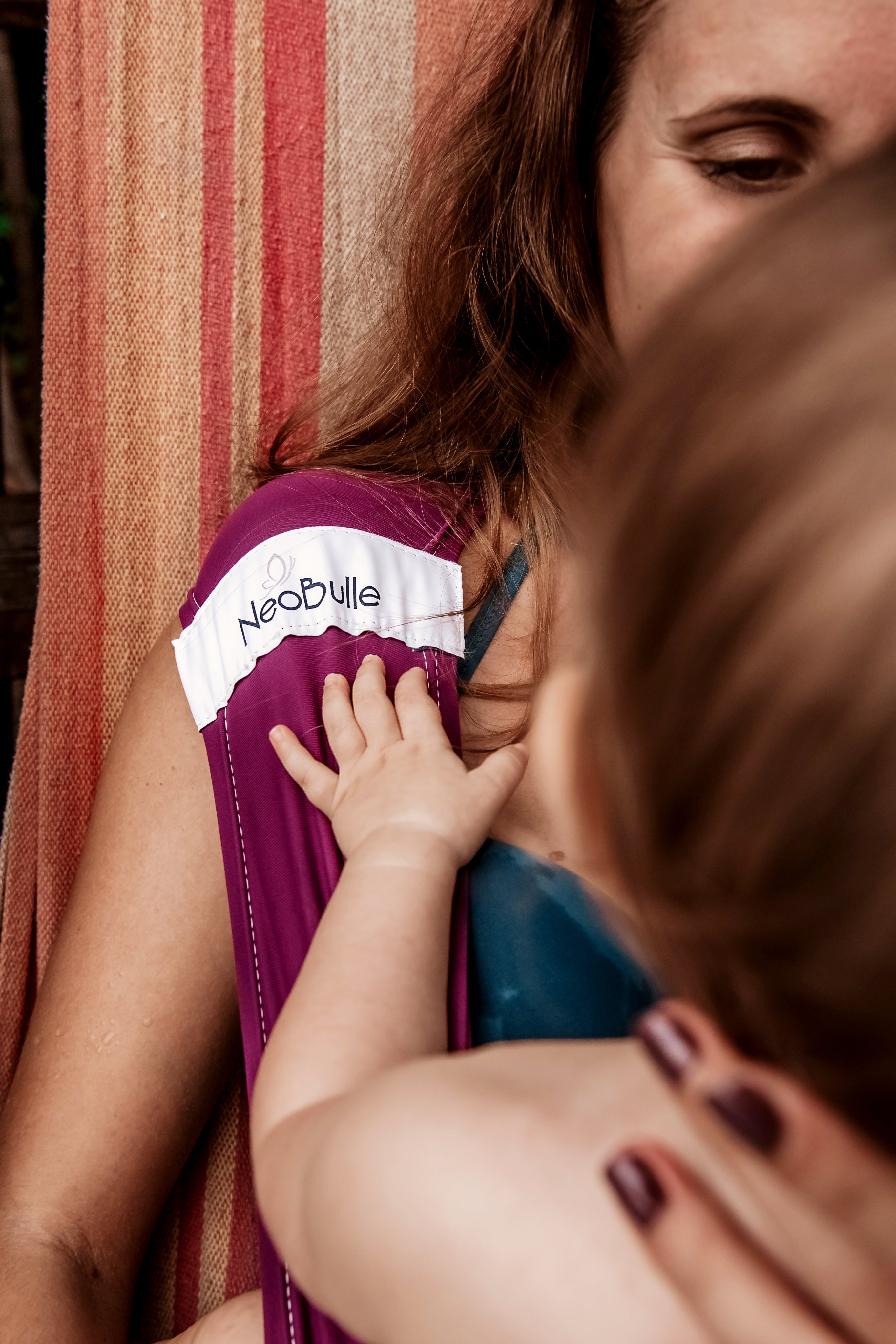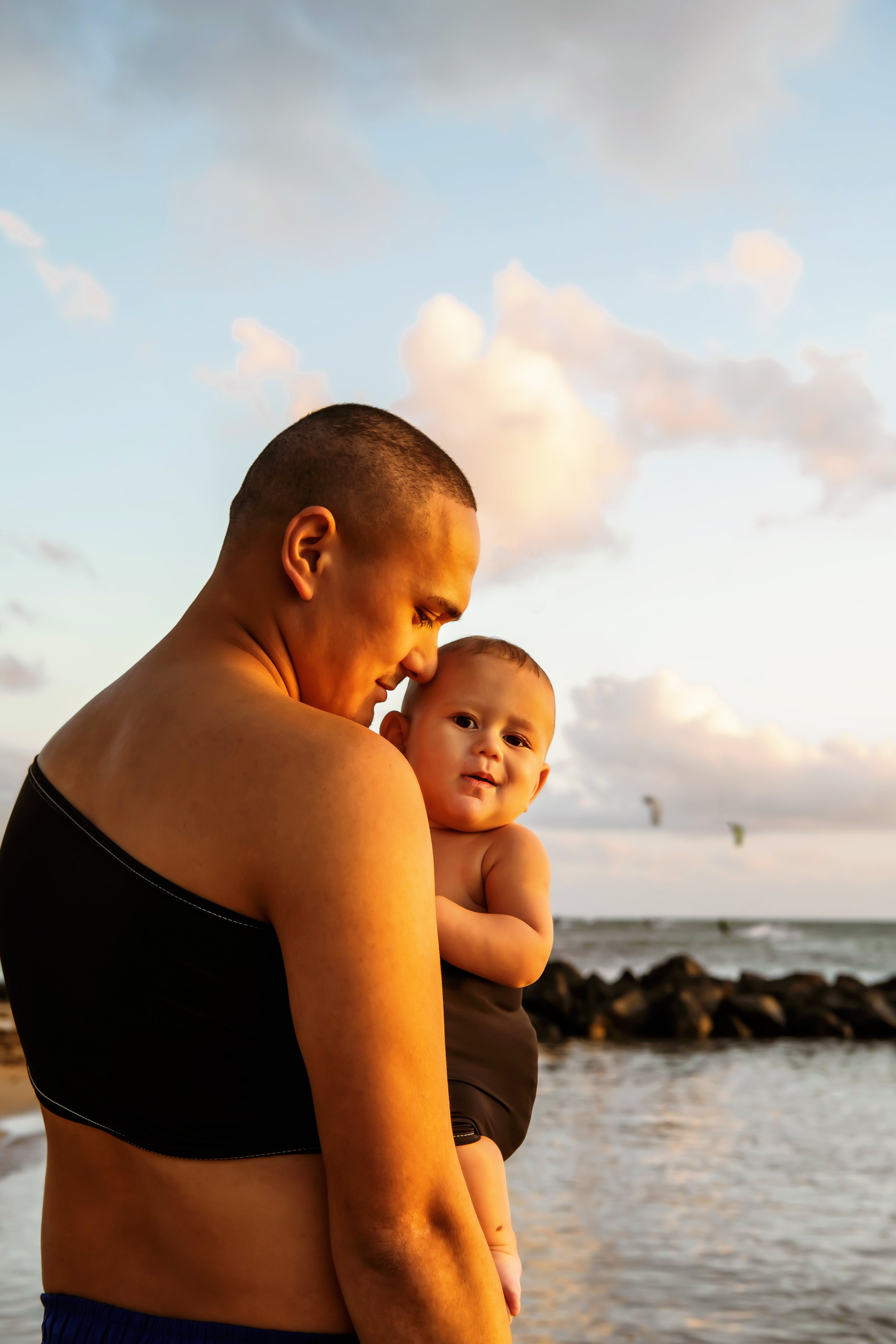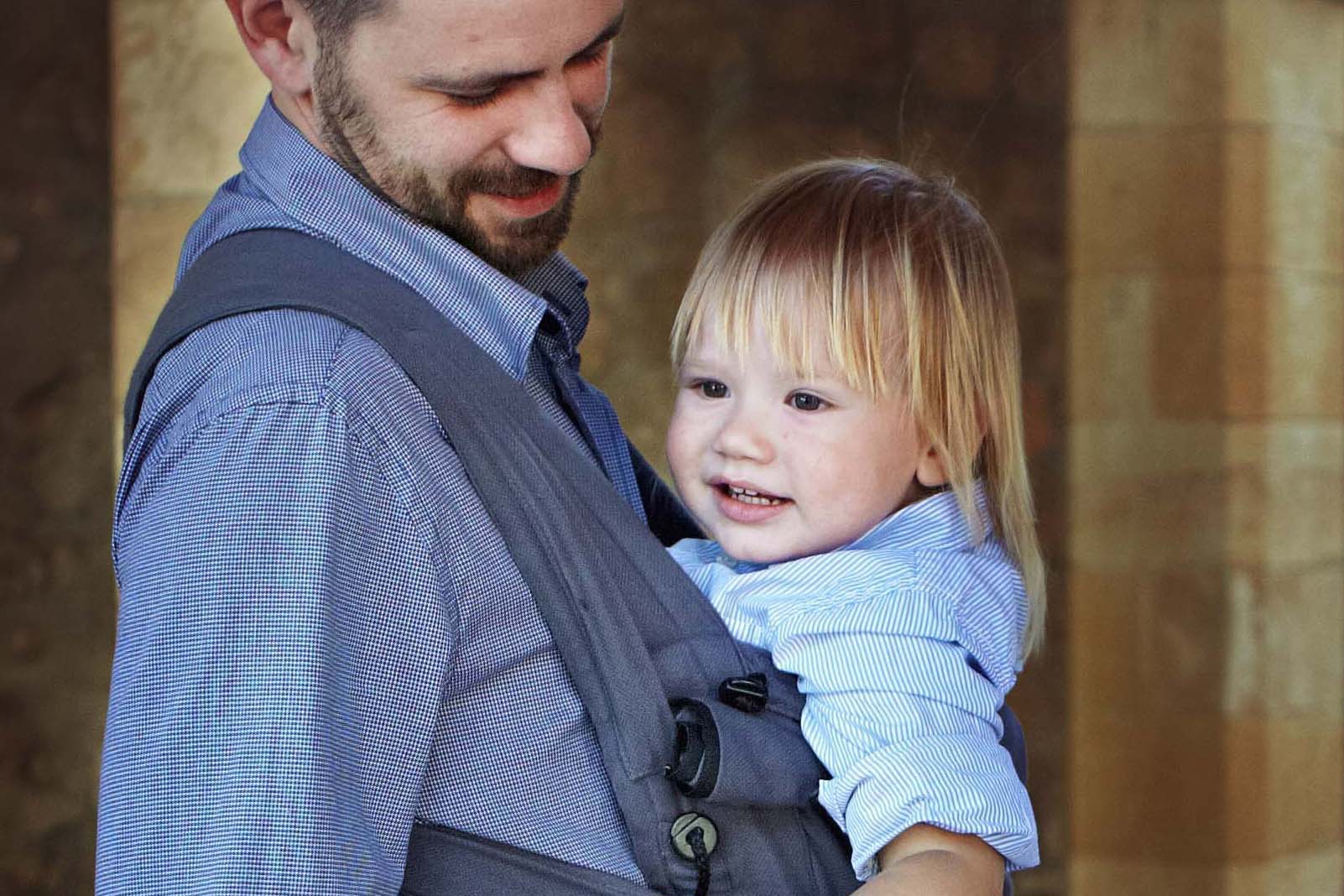
Carrying a growing child
Though it seems both distant and close, that time when your little heart measured 50cm and fell asleep cuddled against you in the sling in just seconds... Now babychou has grown, and the setups look more like a wrestling match than a gentle moment of relaxation. Won't it end up being too heavy? Is carrying still possible (and desirable) with a larger child? The needs of the toddler When discussing carrying a growing child, the common argument heard is that anyway, from 1 or 2 years old, they will walk, implying that it will no longer be necessary to carry them. On paper, this is true; in reality, a little one will not have the same endurance as an adult and unless they are a very good walker, they will inevitably end their journey in the arms or on the shoulders of their caregiver. You have understood it, even full of good will, your favorite can quickly become tired and need a break. They may also have been scared of something (a barking dog, a honking car...) and thus need a big cuddle to reassure themselves. The planned trip could be longer than expected, or after a somewhat exhausting day at daycare. Whether you like it or not, your toddler will end up on you if they are no longer able to walk! Planning a baby carrier allows you to meet their need for rest and/or contact, without ruining your back and neck in the process. Look up to what ages strollers are typically used for difficult trips, extrapolate for the baby carrier. The physical limits of the carrier The question of the child's weight is also a recurring topic when discussing the continuity of carrying over several years. Three important notions should be highlighted: The first is that you do not suddenly wake up one morning thinking, “Well, if I carry my 3-year-old, 15kg child whom I have never carried before...” At least, this is strongly discouraged! Carrying is part of a continuity since birth. We handle a newborn of 3kg, then 4, 5... Our body gradually and gently adapts to the increasing load, we strengthen our muscles, and we gradually adjust our postures as well. Then, outside of pathology or disability, a larger child fortunately does not have the same needs as a newborn! If the toddler can stay with their parents for several hours a day, the 2-year-old will alternate walking and carrying and we will have them on us only in small chunks of 10-15 minutes. Finally, from a purely physical point of view, it is considered that the child's weight begins to impact the health of its carrier from 30% of their weight. Understand that if you weigh 70kg, your toddler will start to feel quite heavy from about 21kg (which is roughly around 6 years old... That leaves some margin!). These are obviously trends, which should be adapted to your form (someone sporty will support a heavier load) and the duration of carrying (the impact is not the same for 5 minutes or 2 hours). Generally speaking, we will favor installations on the back, which put less strain on the carrier's body. Choosing your equipment Parents of a child in the terrible twos know it: they live dangerously! Their child is in the midst of an emotional hurricane and transitions seamlessly from total cooperation in good humor to a remake of The Exorcist, all over a dark story about an open cookie bag when he wanted to do it himself like a big kid (even if 10 seconds before he asked for help to do it, that doesn’t count). Your child is walking well and you think, "We no longer need a carrying system"? That’s ignoring the duality of said carrier. Scenario, starting a walk: "I want to walk! I want to walk!!!" You wanted to go left? Too bad, here he is going right. After 100 meters, he clings to your leg whining, you have to carry him. 100 meters later, he saw a butterfly, he wants to walk. Another 100 meters, he’s back on the verge of despair, he needs to be carried. Another 100 meters, "Oh!!! a dead leaf!!! I want to walk!!!" etc As you can see, the babywearing sling is definitely not the recommended system in this kind of situation (lest you have to fight a furious urge to make him swallow it after 300 meters... without salt...). Too tedious to install/uninstall every 3 minutes! A preformed baby carrier clipped to the waist, a sling, or even a support for carrying on the arms like Hop-la allow you to climb or descend your little sprite without a headache. The type of material will also depend on the length of the walk; if it’s a bit long, it’s better to favor the comfort of the preformed, if it’s for a shorter trip, a sling or Hop-la might suffice! Another argument in favor of these systems: they all allow quick setup, which is not negligible when you have to deal with a grenade ready to explode (meaning: a child not at all cooperative who won’t give you time to make your little adjustments calmly). They are also all compact, and better tolerated by little ones discovering their motor skills and who love to move freely without feeling restricted. Everyday constraints You cannot discuss carrying a growing child without also mentioning the daily life of the family, and the constraints associated with it. Having a walking child also means accepting going at their pace. Is your usual home-nanny commute taking 5 minutes? It will probably take 30. If you're lucky. Sorry, preparing the meal cannot compete with the beautiful pebble that little Choupinou just found and absolutely wants to take the time to admire. In an ideal world, we could take the time to admire all the pebbles on the path, but in real life, you will sometimes have to speed up a bit and carry your child to arrive at your destination within a reasonable timeframe. Depending on the environment, it may sometimes be difficult to let your child walk because they will not be safe. Either because the area is full of too many tempting dangers, or because your little one is tired and switches to headless chicken mode, running around without thinking or paying attention to their surroundings. Putting them on you is then a good way to keep them safe. This is often useful, for example, for city trips when crossing multiple busy roads. It goes without saying that it is unlikely they will agree with your way of seeing things in these moments (fatigue doesn’t help with cooperation), so we come back to the previous point: choose a system where you can zip them up while they scream and fight. It should also be noted that it is safer in these conditions to use a carrying system than just your arms, from which they risk falling or escaping! Finally, once at home, they might also seek your attention and cuddles while you have things to do. Picking them up for a little while then allows you to balance your needs and avoid tensions and frustrations. For example, you could place them on your back while preparing dinner, thus providing the necessary emotional support to decompress from their day, and a view of what you are doing to satisfy their natural curiosity and involve them in your daily life. You understand, it’s not because a child is growing up that carrying them is no longer useful. Just like the advice given for a toddler, as long as you carry them, it’s better to use a carrying system and protect your body as much as possible! The baby carrier remains a weighty ally in daily life and preserves family peace.
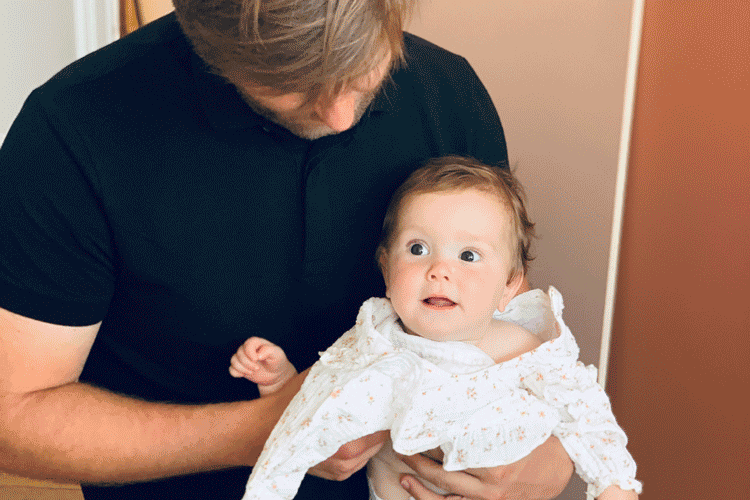
Carrying baby facing the world
The question of carrying your baby facing the outside comes up very regularly as your baby grows and becomes more interested in what's around him. Logically, when he starts to unscrew his neck to observe everything, we can be tempted to turn your baby outwards to satisfy his curiosity. We are then often asked at what age this is possible, or if our baby carriers allow it. In reality, this is a practice that is rather discouraged and in fact our baby carriers do not allow it. We explain why! 1 – respect for physiology When we discuss the physiology of the toddler, the generic benchmarks given are to check that his base (= his pelvis) is well supported with a wide material base which extends to the hollows of the knees , that the knees come up a little higher than the axis of the hips , and that the natural roundness of his back is preserved. When you turn your baby outwards, there are several concerns: It is difficult to maintain the "sitting" posture and in particular to keep the knees raised. The material gathers between the legs and we find ourselves carrying in suspension with the legs hanging down. While the baby carrier may be able to maintain the correct leg posture, the padding used for stabilization quickly ends up sagging and/or being too short and no longer fulfilling its role. The baby's back is pushed by the contours of the wearer's torso (breasts, pectorals, etc.) against which it is resting, preventing natural rounding in favor of an arch . It's a shame to use a carrying system that claims to be respectful of the physiology of the little one only to end up with a posture that isn't! 2 – stimulations Faced with the world, babies find themselves overwhelmed by an incredible quantity of stimuli , which their developing brain will have difficulty processing. First of all, EVERYTHING is new and unknown to him. Lights, sounds, colors, passers-by, trees, cars, buildings, etc. Being naturally curious , he will try to observe everything in detail, which you will agree is exhausting ! It is also transported at the speed of its carrier, which being much larger than it will also go much faster , and will therefore attempt to carry out its observation work but at an accelerated pace . Certain things are likely to frighten him , like the dog barking as you pass, or the granny rushing towards him to go "gouzi-gouzi" by touching him... In this case he will be "stuck" in front of what frightens him , without being able to avoid it, nor curl up against you, nor seek the support of your gaze. It's a bit like landing on another planet and instead of giving you time to take everything in smoothly, you're being offered a fast-track tour! Even if you're very, very curious and really, really want to see everything really quickly, the experience wouldn't be the most pleasant or ultimately very enriching. An overstimulated child may become nervous, tense, cry more, and have increased difficulty falling asleep . NB: the same problem arises in a stroller and it is not recommended to put the child facing forward until he is able to move on his own. 3 – security If the two previous points were more suggestive and subject to your personal sensitivity, this last one is on the other hand much more notable because it concerns the basic security of your carrying. Facing the world, your child is no longer one with you, his weight is felt much more, he pulls you forward , his movements can unbalance you, and he obstructs your field of vision. This drastically increases the risk of falling forward , and that you find yourself crashing face down on the ground with your baby (himself face down). We won't draw you a picture: the consequences could be serious! Obviously, even when carried in front of you, it is possible to fall, however the risk of this occurring is much lower because the child is less in your way and throws you off balance, and above all you will more easily succeed in protecting your little one a little or tipping to the side, and the parts that will absorb the shock will be less fragile (back of the skull and back versus face, rib cage and abdomen). It is the same principle that applies when in judo we learn not to fall forward. “Yes, but my baby is crying out!” Children are naturally very curious , so it's only natural that they want to see as many things as possible! Put yourself in their shoes, lying on your stomach, and in the end they can only see the underside of your neck or your shoulders (the bust line is convex and "closes" the visual field), nothing exciting, you'll agree... First of all, let's remember that safety takes precedence over everything else, and that when your child asks for something, sometimes you unfortunately have to say no because you know it won't be good for him . For example, he would certainly be delighted to taste chocolate at 2 months, but you won't give him any. Later, he will certainly also want to cross the road alone, and again you will stop him, even if he cries. In this case, it's not about completely restricting your little one, but rather about adapting the carrying to reconcile their desires with the comfort and safety of everyone. We can suggest several adjustments depending on the context: Carrying on the back: this carrying is possible very early (from birth with a sling), and allows the baby to be carried in the direction of travel, and to see over the shoulder of the carrier or to the sides (the posture of the back offers a convex curvature which opens the field of vision). When there are too many stimuli, he can take refuge against his carrier. Side carry : Off-center carrying allows the baby to better see their surroundings while maintaining eye contact with the wearer. A sling is very practical in this configuration. And by arm? The above points are especially relevant when carrying with a tool. The analysis is slightly different when carrying with a hand: We generally carry by arm indoors , in an environment that is less stimulating than the outdoors and that the child is familiar with. Carrying is intended to last a short time (these little creatures quickly get heavy!) which also reduces fatigue and agitation. The carrier constantly interacts with their baby: either through their gaze and speech, or through their gestures, as they continuously change the position and way of carrying depending on their child's movements. In the event of a fall, it is easier to protect your baby. Carrying the child facing the world in the arms is in fact much less problematic than in a baby carrier. We can recommend positions more on the side to encourage exchanges, and with a child supported in a sitting position by the outside of the knee and not with the hand between the legs (promotes extended positions and wrist pain). Special cases : The advice given above applies to the general case, but there are several situations where it will be necessary to qualify it! Non-exhaustively, we can mention: The carrier's disability : a parent in a wheelchair, for example, might have difficulty placing their child facing them A child with a device (club feet for example): some devices can injure the wearer and/or the baby and require installations facing the world Babies with reflux : Some children with gastroesophageal reflux completely refuse to be positioned facing the carrier, and it may be helpful to find adjustments to face the world. So, apart from special cases, as you will have understood, carrying the baby facing the world using a carrying system is not recommended. The fact that it is offered by several brands and baby carriers unfortunately does not guarantee that it is wise and suitable. Is your baby moaning in front of you? Don't hesitate to get help from a babywearing instructor to adjust your setup and find solutions that work for you!
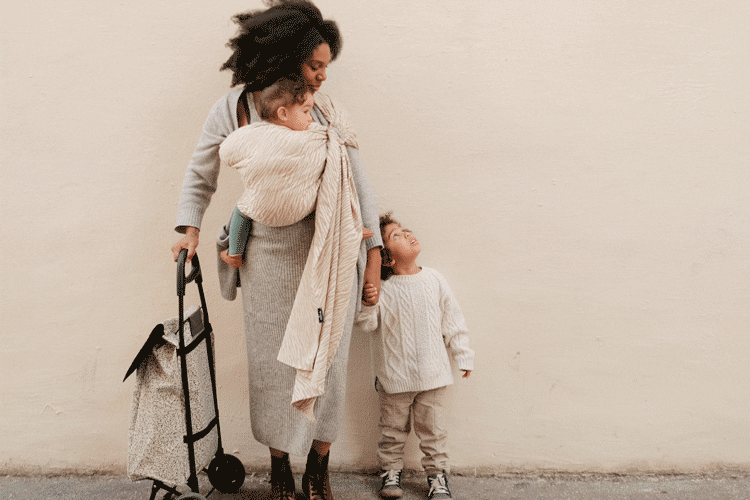
Focus on the sling
Today's article is about the sling, otherwise known as "the scarf with rings" or even more commonly "the thing that's simpler than the scarf but yes, you can see it on the shoulder there." So, who is the sling for, what is it used for, what are the advantages and disadvantages? We'll give you all the details! What is a sling? The sling is a carrying system made up of a strip of fabric (the same as our baby slings) approximately 1.90m long by 0.70m wide , at one end of which 2 aluminum rings are sewn. To use the sling, you must first "assemble" it, as they say in the jargon, by passing the other end of the material through the two rings, then again in the other direction between the two rings (a bit like the double-buckle belts found in some sportswear). The main features of the sling The sling is put on a bit like a Miss France (or Mister Universe) sash, slung over the shoulder of the wearer , with the excess material hanging from the rings like a tie . The baby is placed vertically in the pocket thus created (like in a sling), and the adjustment is easily done with one hand by applying tension around the baby via the tie which comes out of the rings. Due to its configuration, the sling requires off-center carrying . In fact, on the wearer's torso, two elements must be positioned: the baby and the rings. If the baby is positioned in the center of the torso, there is no more room for the rings and this can lead to problems with the stability of the installation (the material near the rings is quite grouped and cannot encompass the baby's entire seat, stopping instead at mid-thigh instead of the hollow of the knee) and discomfort (it cannot be adjusted correctly because the baby ends up stuck to the rings). The choice of side depends on our laterality: the rings are most often installed on the predominant side because on the one hand it is the arm which will then be the freest (for eating, for example), and on the other hand we are generally more precise in adjusting with our dominant hand. For 95% of right-handers, the rings will be on the right. The situation for left-handers is more ambiguous and depends on how much we upset them when they were younger! The sling is a carrying system that has stood the test of time ; it can be used with a newborn as well as an older baby (in addition to a system that distributes the load better). It is particularly ideal when you need to carry a toddler who is tired of walking for a few minutes. What are the advantages of the sling? The sling is THE practical system par excellence! It does not drag on the ground during installation, can be easily adjusted and de-adjusted with one hand, can be set up in record speed , and requires very little handling . At the expert level (understand: not in the learning phase!), it is the only carrying system that can be installed directly with a baby in your arms without the need to put them down first (useful when they have FINALLY fallen asleep on you, weigh a dead donkey in your arms, but will wake up instantly as soon as they are in their bed). It also allows you to breastfeed while carrying without difficulty. This is the system that you put on in 2-2 for all the little daily carrying tasks , to go and get the mail, throw out the garbage, buy bread, do a quick little errand after getting out of the car, or even to take an older child to school or nursery (NB: at the expert level the sling can be perfectly installed while running after the older child who does not want to put their shoes where often for the others, you have to stay stopped while making the adjustments) but also when the baby is grumpy, wants to be held then no longer wants them... It's both a cocoon for baby and space-saving for the wearer. Taking up little space, it slips easily into the trunk, diaper bag, stroller tray, or around your neck as a scarf. Its off-center use makes it a great ally in everyday life: when baby is on his stomach, he takes up all your space and hinders your mobility, making it more difficult, for example, to pick up an object from the floor, empty the dishwasher, or just, more prosaically, to eat. Your little one is a little more open to the outside world and will more easily observe his environment, or what you show him. Bonus: the space freed up on your chest also allows older children to come and cuddle without their little brother or sister blocking the way. The disadvantages of the sling Since perfection is not of this world, carrying in a sling also has some disadvantages! Off-center carrying on one shoulder also means that the sling is not intended to be used for long periods of time. It is a model primarily designed for backup ! If you plan to go on long walks while carrying a baby, it is better to plan for another system as a complement, otherwise your back and neck may painfully remind you to be careful. We could compare baby carriers to pairs of shoes. The baby sling would be the equivalent of a pair of hiking boots, which you take the time to adjust properly and then walk for a long time without pain. The sling is the pair of flip-flops for babywearing , the shoes you put on "on the fly" to go out quickly without hurting your feet but in which you won't cover a long distance. The subtlety lies in the fact that most of the daily carrying times are ultimately short . No one puts on a scarf for 5 minutes, a sling yes. The estimated 5 minutes often turn into 1 hour (we always get caught!), it is better to have installed your baby in a sling than to keep him in your arms without any other support. The comparison of comfort is thus made not between the scarf and the sling but rather between the sling and the arms . We do at least worse in a way. Someone whispers in my earpiece that it would be enough to change shoulders each time you carry them to balance them: this would be like saying to write with your left hand to relieve your right wrist when you are right-handed, unless you are perfectly ambidextrous, no one does that (and even then, even ambidextrous people ultimately have a preferred side!). In a very hectic daily life with a toddler, we tend towards the easy option, namely always carrying on the usual side . Another small warning: its simplicity of use also paradoxically makes it a system that is sometimes complicated to understand. As with all other baby carriers, it is advisable to take the time to understand the mechanism of use and to take the time to learn how to use it . The main technicality consists of keeping the rings high on the shoulder during installation, the problems of rings "which descend" are often listed in the problems of use. This is entirely linked to the off-center configuration of the carrying: as soon as we start to position the baby in the center at the beginning of installation, this mechanically makes the rings descend when we try to shift the baby a little since we pull the sling with it. To overcome this, simply remember that we cannot work in front , we will make sure to pick up the baby as if we wanted to install him on the hip and move him as far away from the rings as possible when we sit him in the material. The adjustments then bring baby and rings closer together, so you must anticipate by being at the beginning a little further on the hip than what you want at the end. At the end of installation, the rings should be roughly at the height of your child's head . Don't hesitate to get help from an instructor to learn! In short, you will have understood, the sling is an everyday essential . If it generally needs to be supplemented by another baby carrier which distributes the load better in case of a walk, it is the hands-free kit par excellence which will delight you with its practicality and its relative simplicity of use.
